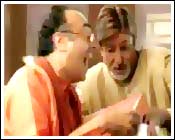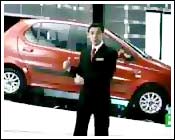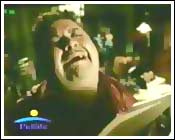|
|
| Help | |
| You are here: Rediff Home » India » Get Ahead » Careers » Information You Can Use |
|
| |||||||||||||||||||||||
|
| |||||||||||||||||||||||
The media industry is booming.
There has been a steep rise in the number of television channels, which has meant a lot more programming and many more advertisements vying for the consumer's attention.
The question many advertising professionals and students are pondering over is -- how will your ad create an impact amidst such clutter?
What must you keep in mind while striving to make an advertisement that works?
Top advertising gurus like Rohit Srivastava, vice president, account planning, Contract Advertising; Abhijeet Awasthi, creative director, O&M; Josy Paul, country head & national creative director, RMG Davidshare and Hanoz Mogrelia, creative director, Saatchi & Saatchi share their advertising mantras with you.
Humour scores
 Rohit Srivastava, Contract Advertising (they've done campaigns like Cadbury's Celebrations, Shoppers' Stop), says, "People do not watch the media for advertisements. Ads, by and large, tend to be an interruption. When a commercial is entertaining, the viewer's indifference can be overcome."
Rohit Srivastava, Contract Advertising (they've done campaigns like Cadbury's Celebrations, Shoppers' Stop), says, "People do not watch the media for advertisements. Ads, by and large, tend to be an interruption. When a commercial is entertaining, the viewer's indifference can be overcome."
While this can be done in a number of ways, like using emotions to move the viewer or by tickling his funny bone, it is the use of humour that remains one of the most preferred methods of making an ad memorable.
"Humour is the best way to cut clutter. If your ad manages to bring a smile to the viewer's face, half the job is done. It ensures instant brand recall," says Abhijeet Awasthi, O&M (their campaigns include Hutch, Cadbury's Dairy Milk, Fevicol, Fevikwik).
Know when to use it
Advertising, like any other field, does not have any absolute thumb rules; in fact, the rules of the game are contextual. In other words, the strategy you employ while creating an ad or a campaign will vary from product to product, depending on the objective of your campaign and the kind of audience you wish to target.
Srivastava says, "Humour is a very powerful tool. It is one of the strongest hooks. At the same time, young advertising aspirants must realise advertising is not only about entertainment. The eventual goal is to build a brand and help increase sales. So the decision on whether to use humour, and to what extent one must use it, should depend on the message your brand wants to give out."
 He further explains, "Humour is best suited for products that a consumer would buy instinctively; say, a chewing gum or a soft drink. These brands won't be persuasive, per se, but they will attempt to make an impact by making the viewer laugh. If the consumer needs to make an important decision while selecting your brand, for example, a car or an insurance policy, then humour, if at all it is used, must be imbibed with the message."
He further explains, "Humour is best suited for products that a consumer would buy instinctively; say, a chewing gum or a soft drink. These brands won't be persuasive, per se, but they will attempt to make an impact by making the viewer laugh. If the consumer needs to make an important decision while selecting your brand, for example, a car or an insurance policy, then humour, if at all it is used, must be imbibed with the message."
A good example would be the Tata Indica V2 commercial, which brings a smile to the viewer's face even as it makes a strong point about the unique features the car offers.
Know how to use it
The kind of humour used in a commercial must depend on the target audience. Hanoz Mogrelia, Saatchi & Saatchi, (Sunsilk, UNICEF, Toyota) elaborates on the kind of humour an advertisement may use. According to him, the humour may be:
~ Exaggerated This may be targeted at kids and teenagers.
This may be targeted at kids and teenagers.
Indians have a penchant for a little bit of melodrama and exaggerated humour can be a hit if used intelligently.
An example of exaggerated humour is the Fevicol 'Pakde rehna, chodna nahin' ad.
~ Subtle
Fevicol's famous ad, which shows a rickety, overcrowded truck with many people hanging onto it, is a satirical take on the crowded travel conditions in India. It steers towards subtlety, because it mirrors real life and says a lot without 'literally' saying anything.
Such ads are generally targeted towards adults and are a great hit internationally too. The Fevicol ad won a Silver Lion at Cannes [Images], an award at The One Show and was also a finalist at the Clio Awards.
~ Black This type of humour mirrors life and is targeted at adults.
This type of humour mirrors life and is targeted at adults.
An example can be the M-Seal 'Ek tapakti boondh' advertisement.
Josy Paul, country head & national creative director, RMG David, (NITCO Paints, INTELENET) says, "The viewer will laugh when he or she identifies with the advertisement.
 Take the case of the Fevicol bus ad or the Alpenliebe 'Lagey raho' ad.
Take the case of the Fevicol bus ad or the Alpenliebe 'Lagey raho' ad.
These advertisements are a tongue-in-cheek view at what happens around us."
Talk in the consumer's language
Leaving aside just humour, the consumer must be able to identify with the ad. Talk in the people's language, think like they would, and half your job is done.
A famous example would be the Surf Lalitaji campaign in the 1980's, which instantly connected with housewives around the country. Lalitaji was the main character in the commercial, a brainchild of ad guru Alyque Padamsee. She was a typical Indian housewife who bargains with shopkeepers but emphasises it is better to buy a product that is value-for-money than buying one that is cheaper but not as effective.
Laugh = Buy?
Yes, humour cuts clutter for the brand but, at the end of the day, does it contribute in increasing sales? Although certain brands say they have experienced an increase in sales after a particularly witty, attention-catching ad, at the end of the day, most admen believe it does not guarantee an increase in sales even if it is a brilliant way of cutting clutter.
Paul says, "The viewer may not want to spend his hard-earned money on an expensive product just because the commercial made him laugh. It works sometimes, doesn't at others. There is no hard and fast rule. Sales will increase if the ad has the right message, if the entire campaign is well-planned and if the product lives up to its claims."
Srivastava agrees, "Building salience for the brand is most important. Brand salience means that your brand is the first thing that comes to the consumer's mind when he thinks of that particular line of products. For example, until a short while ago, Bisleri was synonymous with mineral water. How you go about building brand salience -- whether you use humour or emotions or a celebrity -- is secondary."
Tips for advertising aspirants
~ Focus on sales
All these ad professionals were unanimous about one thing. Advertising is not always about making great-looking, intelligent ads.
At the end of the day, you are being paid by a client to increase his product's sales -- so THAT ought to be your primary concern.
~ Analyse other ads
Watch advertisements that come on the tube and analyse them -- see whether the commercial convinced you to buy the product; if yes, then what convinced you, and if not, then what, in your opinion, did the ad lack? The more advertisements you watch with a keen eye, the more your knowledge will increase.
~ Look for inspiration
Have a keen and observant eye and allow society to be your inspiration.
~ Write, write, write
The only manner in which you can hone your writing skills is by writing. And writing doesn't mean using high-brow language. Write simple. In advertising, you have to express complex emotions and thoughts in simple words.
~ Understand the objective of your campaign
You need to know whether your campaign is introducing your brand in the market, or building its image, or informing the viewer about a particular offer, and so on.
~ Zero in on your target audience
Build your campaign depending on the target audience. The style of the commercials, the language used, the situation depicted, the kind of humour used, if any, all these factors depend on your target audience.
Advertising is all about role-playing. You have to put yourself in the shoes of the specific group of consumers you intend to target. Make the viewer identify with what you are saying.
Srivastava concludes by saying, "Humour is a means, and not the end. Moreover, it is just one of the means. The first step is for you to decide the objective of your campaign. Identify problems you may face and opportunities you may avail of. Remember the most important rule of advertising -- there are no rules."
DON'T MISS!
Click here for advertising jobs.
|
|
| © 2008 Rediff.com India Limited. All Rights Reserved. Disclaimer | Feedback |